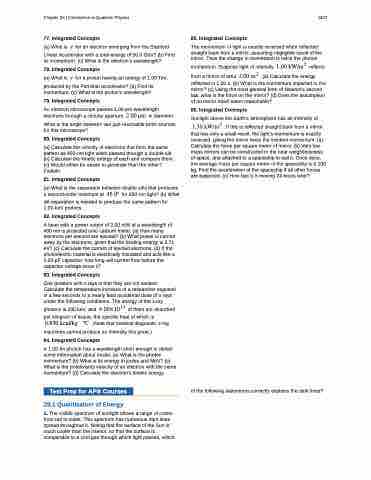Page 1339 - College Physics For AP Courses
P. 1339
Chapter 29 | Introduction to Quantum Physics
1327
77. Integrated Concepts
(a) What is � for an electron emerging from the Stanford Linear Accelerator with a total energy of 50.0 GeV? (b) Find
its momentum. (c) What is the electron’s wavelength?
78. Integrated Concepts
(a) What is � for a proton having an energy of 1.00 TeV, produced by the Fermilab accelerator? (b) Find its
momentum. (c) What is the proton’s wavelength?
79. Integrated Concepts
An electron microscope passes 1.00-pm-wavelength electrons through a circular aperture ���� �� in diameter.
What is the angle between two just-resolvable point sources for this microscope?
80. Integrated Concepts
(a) Calculate the velocity of electrons that form the same pattern as 450-nm light when passed through a double slit. (b) Calculate the kinetic energy of each and compare them. (c) Would either be easier to generate than the other? Explain.
81. Integrated Concepts
(a) What is the separation between double slits that produces a second-order minimum at ����� for 650-nm light? (b) What
slit separation is needed to produce the same pattern for 1.00-keV protons.
82. Integrated Concepts
A laser with a power output of 2.00 mW at a wavelength of 400 nm is projected onto calcium metal. (a) How many electrons per second are ejected? (b) What power is carried away by the electrons, given that the binding energy is 2.71 eV? (c) Calculate the current of ejected electrons. (d) If the photoelectric material is electrically insulated and acts like a 2.00-pF capacitor, how long will current flow before the capacitor voltage stops it?
83. Integrated Concepts
One problem with x rays is that they are not sensed. Calculate the temperature increase of a researcher exposed in a few seconds to a nearly fatal accidental dose of x rays under the following conditions. The energy of the x-ray
photons is 200 keV, and ��������� of them are absorbed per kilogram of tissue, the specific heat of which is
����� ������� � �� . (Note that medical diagnostic x-ray machines cannot produce an intensity this great.)
84. Integrated Concepts
A 1.00-fm photon has a wavelength short enough to detect some information about nuclei. (a) What is the photon momentum? (b) What is its energy in joules and MeV? (c) What is the (relativistic) velocity of an electron with the same momentum? (d) Calculate the electron’s kinetic energy.
Test Prep for AP® Courses
29.1 Quantization of Energy
1. The visible spectrum of sunlight shows a range of colors from red to violet. This spectrum has numerous dark lines spread throughout it. Noting that the surface of the Sun is much cooler than the interior, so that the surface is comparable to a cool gas through which light passes, which
85. Integrated Concepts
The momentum of light is exactly reversed when reflected straight back from a mirror, assuming negligible recoil of the mirror. Thus the change in momentum is twice the photon
momentum. Suppose light of intensity ���� ����� reflects from a mirror of area ���� �� . (a) Calculate the energy
reflected in 1.00 s. (b) What is the momentum imparted to the mirror? (c) Using the most general form of Newton’s second law, what is the force on the mirror? (d) Does the assumption of no mirror recoil seem reasonable?
86. Integrated Concepts
Sunlight above the Earth’s atmosphere has an intensity of ���� ����� . If this is reflected straight back from a mirror
that has only a small recoil, the light’s momentum is exactly reversed, giving the mirror twice the incident momentum. (a) Calculate the force per square meter of mirror. (b) Very low mass mirrors can be constructed in the near weightlessness of space, and attached to a spaceship to sail it. Once done, the average mass per square meter of the spaceship is 0.100 kg. Find the acceleration of the spaceship if all other forces are balanced. (c) How fast is it moving 24 hours later?
of the following statements correctly explains the dark lines?


